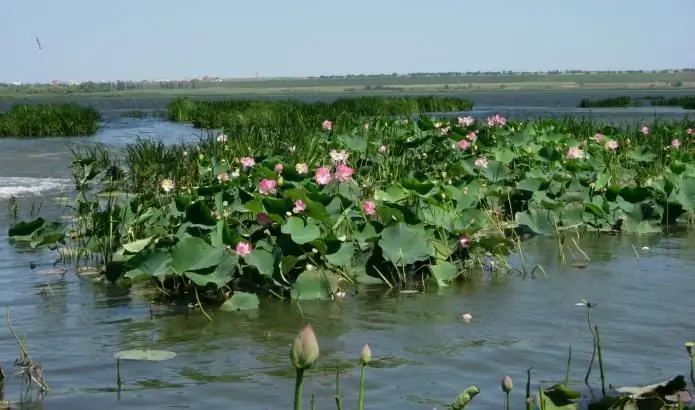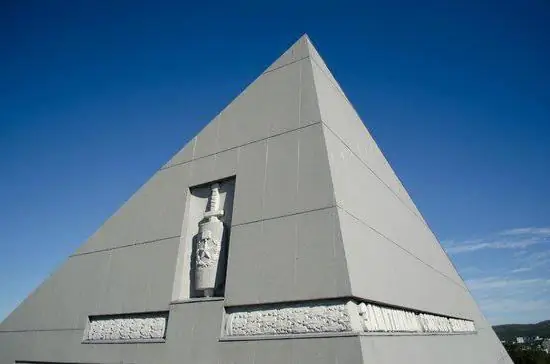- Author Harold Hamphrey [email protected].
- Public 2023-12-17 10:06.
- Last modified 2025-01-24 11:10.
Although the war with Nazi Germany ended a long time ago, our country still keeps traces of those terrible years. The Kola Peninsula is one of the most striking examples. Today, these places attract many tourists. They come from different republics of the former USSR and even from abroad to watch solemn holidays or just to get acquainted with the conditions in which our soldiers fought and what victory cost them.
A bit of geography
Valley of Glory is located on the right bank of the Western Litsa River. From Murmansk only 40 kilometers. This is if you move in a straight line. And if you go by car along the highway - already 74. In general, this is not far from the place where the Western Litsa River flows widely.

The valley seems to be hidden between gentle hills. Stretches for thousands of meters. Somewhere it breaks. Now a stream runs, then a swamp underfoot, or even a pass. This is a beautiful area. After all, here is a rare landscape of the plain, unusual for the northern latitudes. In summer, the grass is quite tall everywhere. Silence. Only the birds sing. Very majestic, solemn. It's breathtaking.
Name change
Here along the river (from July to November 1941) was the defense line. Today even imagineit is difficult, how in such places it was possible to carry out at least some, the most simple military operations. Plus, it's pretty cold here in the summer. Tundra! And they held the defense here in the fall. So our people had very considerable losses in battles, not just because of such, to put it mildly, unsightly weather conditions.
And how many difficulties it was to deliver weapons and ammunition to the fighters. To this day, various remains of both Soviet and German equipment and weapons are found in this area.
But people endured everything. It was the Valley of Glory that became an insurmountable obstacle for the German troops. They received an order to capture Murmansk as soon as possible. To do this, here, through the impenetrable tundra, they sent "Norway" - a mountain corps. It consisted mainly of Austrian and Norwegian soldiers. They were commanded by German Colonel General Eduard Dietl.
But the enemy received a powerful rebuff from the Soviet troops when he tried to cross the river. The military, led by the commander of the 205th Infantry Regiment, Anatoly Ivannikov, not only resisted and did not let the enemy go further, but badly battered the enemy twice as strong.

Moreover, they even fought with their fists. There were real hand-to-hand fights. After all, delivering weapons and ammunition to the tundra, and even off-road, turned out to be incredibly difficult.
And the Valley of Glory (Murmansk region) saw a lot of such fights. More than two thousand people died on the banks of the river during the entire confrontation. And along the surrounding hills - for several tens of kilometers - still liesscattered German weapons.
Also, the trenches and fortifications are safe and sound. Yes, many of our brave fighters were killed here. It is no coincidence that the soldiers called this place Death Valley. And nowadays the name has been changed to a lighter, more memorable one.
Memorial to the Defenders
Today the Valley of Glory is, first of all, a large Memorial complex. It was built on the site of those tragic and heroic battles. And here is the burial place of soldiers and officers. Warriors who did everything to prevent the enemy from going further inland.
Five years ago the complex was renovated. They also did a reburial. And every year on May 9, the Valley of Glory receives thousands of people who specially come here from everywhere. They want to honor the memory of those who defended the Arctic. Meetings and conversations, stories of witnesses and researchers, historians, and various other events are held here. Activists of military-historical clubs are excavating at the sites of past battles.

Features, attractions
The area itself is very beautiful. She has such a stern, strict, restrained look. That is, you can come here not only to see the famous memorial, but also to admire the unusual nature of the tundra. And also learn something else interesting.
That was the fact. The Germans in 1941-42 built (in the Titovka area) a road. Rope! Purpose: to supply your units with everything you need. This order was issued by Ferdinand Scherner (General of the 6th Mountain Division).
The carrying capacity of the cable car is as follows: from 150up to 250 kilograms. A single cable was in its design, the so-called traction-carrying. Closed moving in a circle. Plus drive.
Of course, the Germans also used the labor of our prisoners of war for this…

The longest cable car
Today anyone can see the remains of this impressive engineering system. Collected it from separate sections. Each was like a loading and unloading platform. She worked on her own and did not depend on others. The trailers were of two types. Or a wooden platform, or a metal bucket. They were attached to a figured metal suspension. When the trolleys got to the station, they were disconnected from the cable (automatically). And already on the monorail (also suspended) they were manually rolled.
When the Germans retreated, they themselves damaged it. Our specialists dismantled the cable car after the war. They let me in for household needs.
It was the longest military cable car.
Good holidays
Would you like to come here? The final destination of the journey is clear: the Valley of Glory (Murmansk region). How to get there, you just need to find out. But you will read about it below.
Activities in the Valley of Glory are varied. So, there is a large volunteer project dedicated to the heroes of the Great Victory. The second movement has the same character - “No one is forgotten. And nothing is forgotten.”
And then there is the “Memory Watch”. Many have heard about her. This June, for example, a combined team from two settlements marched along the defense line (on Zapadnaya Litsa). The guys visited several graves. Created a work plan forrestoration - for the summer of this year. The graves were also cleared of debris. Decorated with flowers.
Finished their watch on June 22 this year. And, of course, at the important Titov frontier.

Unforgettable meetings every year
Valley of Glory (Murmansk region) welcomes guests from everywhere. War veterans, their relatives and friends, "children of war", home front workers go to an event that is repeated annually on the same date. It's, you guessed it, VE Day in the Valley of Glory.
This May, as always, there was a rally. There was a laying of flowers and wreaths at the monuments of the Memorial complex. Representatives of the club "Polar Frontier" staged a reconstruction of military events. It was very impressive. There was also a military song contest. Then we talked with veterans.
70th anniversary of Victory
Festivities took place this year for two days. After all, the date is big! The main theme of the holiday was patriotic education. Therefore, compared to previous years, the Valley of Glory showed more exhibitions - military equipment, small arms. As well as various thematic expositions. The field kitchen also worked.
The organizers of these large-scale celebrations were greatly assisted by volunteers - young guys, students - future social workers. So the celebration in the Valley of Glory turned out to be memorable.

In your car
Well, we convinced you to come here and see for yourself what this famous Valley of Glory is? Howget there, now we will tell you in detail.
By car, the route is like this. Take a course from Murmansk directly to the south. Move only along Podgornaya street. And turn right at the first big turn. You enter the bridge. We went down, we went down. And again turn to the track (on its right side). So you go 74 kilometers. And immediately opens a beautiful view of the Memorial.
You are the first time in these parts, in the Arctic, and your goal is the Valley of Glory (Murmansk region)? How to get there, you naturally want to know. We recommend taking the bus. Several flights run from Murmansk to Pechenga, also to Zapolyarny, to Zaozersk. Suitable for Kirkines.

Depart daily. One after another follows every hour. Check out the schedule in advance. And be sure to check the departure time of the last bus.






